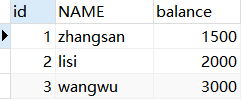数据库连接池
-
概念
其实就是一个容器(集合),存放数据库连接的容器。
当系统初始化好后,容器被创建,容器中会申请一些连接对象,当用户来访问数据库时,从容器中获取连接对象,用户访问完之后,会将连接对象归还给容器。 -
好处
- 节约资源
- 用户访问高效
-
实现
- 标准接口:DataSource javax.sql包下的
方法:
获取连接:getConnection()
归还连接:Connection.close()。如果连接对象Connection是从连接池中获取的,那么调用Connection.close()方法,则不会再关闭连接了。而是归还连接 - 一般我们不去实现它,有数据库厂商来实现
- C3P0:数据库连接池技术
- Druid:数据库连接池实现技术,由阿里巴巴提供的
- 标准接口:DataSource javax.sql包下的
C3P0使用实例
步骤
1.导入jar包(两个)这里我是:c3p0-0.9.5.2.jar mchange-commons-java-0.2.12.jar(数据库驱动jar包也不要忘记)
2.定义配置文件
名称:c3p0.properties 或者 c3p0-config.xml(这里的配置文件名称是规定的,不能自定义名字)
路径:直接将文件放在src目录下
Demo
package demo_jdbcpool;
import com.mchange.v2.c3p0.ComboPooledDataSource;
import javax.sql.DataSource;
import java.sql.Connection;
import java.sql.PreparedStatement;
import java.sql.ResultSet;
import java.sql.SQLException;
public class c3p0_demo {
public static void main(String[] args){
Connection conn = null;
PreparedStatement pst=null;
ResultSet rs =null;
try {
//新建数据库连接池对象
DataSource ds=new ComboPooledDataSource();
conn = ds.getConnection();
//定义sql语句
String sql="SELECT * FROM account";
//创建sql执行对象
pst = conn.prepareStatement(sql);
rs = pst.executeQuery();
while(rs.next()){
int id = rs.getInt("id");
String name = rs.getString("NAME");
double balance = rs.getDouble("balance");
System.out.println("id:"+id+"name:"+name+"balance"+balance);
}
} catch (SQLException throwables) {
throwables.printStackTrace();
}finally {
if(rs!=null){
try {
rs.close();
} catch (SQLException throwables) {
throwables.printStackTrace();
}
}
if(pst!=null){
try {
pst.close();
} catch (SQLException throwables) {
throwables.printStackTrace();
}
}
if(conn!=null){
try {
conn.close();
} catch (SQLException throwables) {
throwables.printStackTrace();
}
}
}
}
}
结果

Druid使用实例
步骤
1.导入jar包 这里我是:druid-1.0.9.jar
2.定义配置文件
可以叫任意名称的properties,可以放在任意目录下
demo
package demo_jdbcpool;
import com.alibaba.druid.pool.DruidDataSourceFactory;
import com.mysql.jdbc.jdbc2.optional.MysqlDataSourceFactory;
import javax.sql.DataSource;
import java.io.IOException;
import java.sql.Connection;
import java.sql.PreparedStatement;
import java.sql.ResultSet;
import java.sql.SQLException;
import java.util.Properties;
public class Druid_demo {
public static void main(String[] args){
Connection conn = null;
PreparedStatement pst=null;
ResultSet rs =null;
try {
Properties pro=new Properties();
pro.load(Druid_demo.class.getClassLoader().getResourceAsStream("druid.properties"));
//新建数据库连接池对象
DataSource ds=DruidDataSourceFactory.createDataSource(pro);
conn = ds.getConnection();
//定义sql语句
String sql="SELECT * FROM account";
//创建sql执行对象
pst = conn.prepareStatement(sql);
rs = pst.executeQuery();
while(rs.next()){
int id = rs.getInt("id");
String name = rs.getString("NAME");
double balance = rs.getDouble("balance");
System.out.println("id:"+id+"name:"+name+"balance"+balance);
}
} catch (Exception e) {
e.printStackTrace();
}finally {
if(rs!=null){
try {
rs.close();
} catch (SQLException throwables) {
throwables.printStackTrace();
}
}
if(pst!=null){
try {
pst.close();
} catch (SQLException throwables) {
throwables.printStackTrace();
}
}
if(conn!=null){
try {
conn.close();
} catch (SQLException throwables) {
throwables.printStackTrace();
}
}
}
}
}
结果

实现Drudi的JDBCUtils工具类
package demo_jdbcpool.Utils;
import com.alibaba.druid.pool.DruidDataSourceFactory;
import javax.sql.DataSource;
import java.io.IOException;
import java.sql.Connection;
import java.sql.ResultSet;
import java.sql.SQLException;
import java.sql.Statement;
import java.util.Properties;
public class JDBCUtils {
private static DataSource ds;
static{
try {
Properties pro=new Properties();
pro.load(JDBCUtils.class.getClassLoader().getResourceAsStream("druid.properties"));
ds= DruidDataSourceFactory.createDataSource(pro);
} catch (IOException e) {
e.printStackTrace();
} catch (Exception e) {
e.printStackTrace();
}
}
//获取数据库连接
public static Connection getconnection() throws SQLException {
return ds.getConnection();
}
//回收资源
public static void close(Statement st,Connection conn){
close(null,st,conn);
}
public static void close(ResultSet rs,Statement st,Connection conn){
if(rs!=null){
try {
rs.close();
} catch (SQLException throwables) {
throwables.printStackTrace();
}
}
if(st!=null){
try {
st.close();
} catch (SQLException throwables) {
throwables.printStackTrace();
}
}
if(conn!=null){
try {
conn.close();
} catch (SQLException throwables) {
throwables.printStackTrace();
}
}
}
//获取连接池
public static DataSource getDataSource(){
return ds;
}
}
结合JDBCUtils工具类的Druid实例
package demo_jdbcpool;
import demo_jdbcpool.Utils.JDBCUtils;
import java.sql.Connection;
import java.sql.PreparedStatement;
import java.sql.ResultSet;
public class Druid_demo {
public static void main(String[] args){
Connection conn = null;
PreparedStatement pst=null;
ResultSet rs =null;
try {
//新建数据库连接池对象
conn = JDBCUtils.getconnection();
//定义sql语句
String sql="INSERT INTO account VALUES(null,?,?)";
//创建sql执行对象
pst = conn.prepareStatement(sql);
pst.setString(1,"wangwu");
pst.setDouble(2,3000);
int re = pst.executeUpdate();
System.out.println(re);
} catch (Exception e) {
e.printStackTrace();
}finally {
JDBCUtils.close(pst,conn);
}
}
}
结果


Spring JDBC
Spring框架对JDBC的简单封装。提供了一个JDBCTemplate对象简化JDBC的开发
步骤
1.导入jar包
2.创建JdbcTemplate对象。依赖于数据源DataSource
JdbcTemplate template = new JdbcTemplate(ds);
3.调用JdbcTemplate的方法来完成CRUD的操作
update():执行DML语句。增、删、改语句
queryForMap():查询结果将结果集封装为map集合,将列名作为key,将值作为value 将这条记录封装为一个map集合(**注意:这个方法查询的结果集长度只能是1**)
queryForList():查询结果将结果集封装为list集合(**注意:将每一条记录封装为一个Map集合,再将Map集合装载到List集合中**)
query():查询结果,将结果封装为JavaBean对象
query的参数:RowMapper
一般我们使用BeanPropertyRowMapper实现类。可以完成数据到JavaBean的自动封装
new BeanPropertyRowMapper<类型>(类型.class)
queryForObject:查询结果,将结果封装为对象
(一般用于聚合函数的查询)
练习Demo
package demo_jdbcpool;
import demo_jdbcpool.Utils.JDBCUtils;
import org.junit.Test;
import org.springframework.jdbc.core.BeanPropertyRowMapper;
import org.springframework.jdbc.core.JdbcTemplate;
import java.util.List;
import java.util.Map;
public class template_demo {
//这里利用JDBCUtils工具类,获取datasource
//1. 修改1号数据的 salary 为 10000
@Test
public void test1(){
JdbcTemplate template=new JdbcTemplate(JDBCUtils.getDataSource());
String sql="UPDATE emp SET salary=10000 WHERE id=?";
int re = template.update(sql, 1001);
System.out.println(re);
}
//2. 添加一条记录
@Test
public void test2(){
JdbcTemplate template=new JdbcTemplate(JDBCUtils.getDataSource());
String sql="INSERT INTO emp(id,ename,job_id) VALUES(?,?,?)";
int re = template.update(sql, 1015, "张三", 4);
System.out.println(re);
}
//3. 删除刚才添加的记录
@Test
public void test3(){
JdbcTemplate template=new JdbcTemplate(JDBCUtils.getDataSource());
String sql="DELETE FROM emp WHERE id=?";
int re = template.update(sql, 1015);
System.out.println(re);
}
//4. 查询id为1的记录,将其封装为Map集合
@Test
public void test4(){
JdbcTemplate template=new JdbcTemplate(JDBCUtils.getDataSource());
String sql="SELECT * FROM emp WHERE id=?";
Map<String, Object> map = template.queryForMap(sql, 1001);
System.out.println(map);
}
//5. 查询所有记录,将其封装为List
@Test
public void test5(){
JdbcTemplate template=new JdbcTemplate(JDBCUtils.getDataSource());
String sql="SELECT * FROM emp";
List<Map<String, Object>> maps = template.queryForList(sql);
for (Map<String, Object> map : maps) {
System.out.println(map);
}
}
//6. 查询所有记录,将其封装为Emp对象的List集合
@Test
public void test6(){
JdbcTemplate template=new JdbcTemplate(JDBCUtils.getDataSource());
String sql="SELECT * FROM emp";
List<emp> query = template.query(sql, new BeanPropertyRowMapper<emp>(emp.class));
for (emp e : query) {
System.out.println(e);
}
}
//7. 查询总记录数
@Test
public void test7(){
JdbcTemplate template=new JdbcTemplate(JDBCUtils.getDataSource());
String sql="SELECT COUNT(id) FROM emp";
Integer re = template.queryForObject(sql, int.class);
System.out.println(re);
}
}